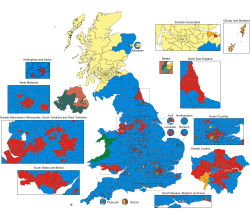A | B | C | D | E | F | G | H | CH | I | J | K | L | M | N | O | P | Q | R | S | T | U | V | W | X | Y | Z | 0 | 1 | 2 | 3 | 4 | 5 | 6 | 7 | 8 | 9
| |||||||||||||||||||||||||||||||||||||||||||||||||||||
All 650 seats in the House of Commons 326[a] seats needed for a majority | |||||||||||||||||||||||||||||||||||||||||||||||||||||
|---|---|---|---|---|---|---|---|---|---|---|---|---|---|---|---|---|---|---|---|---|---|---|---|---|---|---|---|---|---|---|---|---|---|---|---|---|---|---|---|---|---|---|---|---|---|---|---|---|---|---|---|---|---|
| Opinion polls | |||||||||||||||||||||||||||||||||||||||||||||||||||||
| |||||||||||||||||||||||||||||||||||||||||||||||||||||
 Map of the 650 constituencies | |||||||||||||||||||||||||||||||||||||||||||||||||||||
| |||||||||||||||||||||||||||||||||||||||||||||||||||||
The next United Kingdom general election is expected to be held in the second half of 2024,[2] and must be held no later than 28 January 2025.[3][4] It will determine the composition of the House of Commons, which determines the next Government of the United Kingdom. Significant constituency boundary changes will be in effect, the first such changes since before the 2010 general election.
Background
The next election is scheduled to be held no later than 28 January 2025,[3] with Parliament being dissolved no later than 17 December 2024. However, the incumbent government can choose to call the election before then, since the Fixed-term Parliaments Act 2011 was repealed under the Dissolution and Calling of Parliament Act 2022.
The results of the 2019 general election are given below, alongside the current numbers in the House of Commons. Numbers have changed through by-elections, defections and suspensions of members from their party that have taken place throughout the present Parliament.
| Affiliation | Members | |||
|---|---|---|---|---|
| Elected in 2019[5] | Current[6] | Change | ||
| Conservative | 365 | 349 | ||
| Labour[e] | 202 | 198 | ||
| SNP | 48 | 43 | ||
| Liberal Democrats | 11 | 15 | ||
| DUP | 8 | 8 | ||
| Sinn Féin | 7 | 7 | ||
| Plaid Cymru | 4 | 3 | ||
| SDLP | 2 | 2 | ||
| Alba | N/A[f] | 2[g] | ||
| Green | 1 | 1 | ||
| Alliance | 1 | 1 | ||
| Speaker | 1 | 1 | ||
| Independent | 0 | 18[h] | ||
| Total | 650 | 648 | ||
| Voting total[i] | 639 | 636 | ||
| Vacant | 0 | 2 | ||
| Government majority | 87 | 56[k] | ||
For full details of changes during the current Parliament, see By-elections and Defections, suspensions and resignations.
Before this general election, in March 2022 the Labour Party had abandoned all-women shortlists, citing legal advice that continuing to use them for choosing parliamentary candidates would become an unlawful practice again under the Equality Act 2010.[11]
Electoral system
General elections in the United Kingdom are organised using first-past-the-post voting. The Conservative Party, which won a majority at the 2019 general election, included pledges in its manifesto to remove the 15-year limit on voting for British citizens living abroad, and to introduce a voter identification requirement in Great Britain.[12] Provisions for these changes have been enacted in the Elections Act 2022.
Boundary reviews
The Sixth Periodic Review of Westminster constituencies, which proposed reducing the number of constituencies from 650 to 600, was commenced in 2011, but temporarily stopped in January 2013. Following the 2015 general election, each of the four parliamentary boundary commissions of the United Kingdom recommenced their review process in April 2016.[13][14][15] The four commissions submitted their final recommendations to the Secretary of State on 5 September 2018[16][17] and made their reports public a week later.[18][19][20][16] However, the proposals were never put forward for approval before the calling of the general election held on 12 December 2019, and in December 2020 the reviews were formally abandoned under the Schedule to the Parliamentary Constituencies Act 2020.[21]
A projection by psephologists Colin Rallings and Michael Thrasher of how the 2017 votes would have translated to seats under the 2018 boundaries suggested the changes would have been beneficial to the Conservative Party and detrimental to the Labour Party.[22][23]
In March 2020, Cabinet Office minister Chloe Smith confirmed that the 2023 Periodic Review of Westminster constituencies would be based on retaining 650 seats.[24][25] The previous relevant legislation was amended by the Parliamentary Constituencies Act 2020[26] and the four boundary commissions formally launched their 2023 reviews on 5 January 2021.[27][28][29][30] They were required to issue their final reports prior to 1 July 2023.[21] Once the reports have been laid before Parliament, Orders in Council giving effect to the final proposals must be made within four months, unless "there are exceptional circumstances". Prior to the Parliamentary Constituencies Act 2020, boundary changes could not be implemented until they were approved by both Houses of Parliament.
The boundary changes were approved at a meeting of the Privy Council on 15 November 2023,[31] and came into force on 29 November 2023,[32] meaning that the general election will be contested on these new boundaries.[33]
Notional 2019 results

The election will be contested under new constituency boundaries established by the Sixth Boundary Review in 2023. Consequently, media outlets tend to report seat gains and losses as compared to notional results. These are the results if all votes cast in 2019 were unchanged, but regrouped by new constituency boundaries.[34] Notional results in the UK are always estimated, usually with the assistance of local election results, because vote counts at parliamentary elections in the UK do not produce figures at any level below the whole constituency.
In England, seats will be redistributed away from Northern England and towards Southern England due to the different rates of population growth. North West England and North East England will lose two seats each whereas South East England will gain seven seats and South West England will gain three seats.[35] Based on historic voting patterns, this is expected to help the Conservatives.[36] Based on these new boundaries, different parties would have won several constituencies with unchanged names but changed boundaries in 2019. For example, the Conservatives would have won Wirral West and Leeds North West instead of the Labour Party, but Labour would have won Pudsey and Filton and Bradley Stoke instead of the Conservatives. Westmorland and Lonsdale, the constituency represented by former Liberal Democrat leader Tim Farron, is now notionally a Conservative seat.
In Scotland, 57 MPs would be elected, down from the 59 in 2019, with the following notional partisan composition of Scotland's parliamentary delegation:[37] The Scottish National Party benefits the most from the boundary changes as they would have won 49 seats instead of 48. The Scottish Conservatives would have only won five seats instead of six. Scottish Labour would have retained Edinburgh South, the sole constituency they won in 2019. The Scottish Liberal Democrats would have only won two seats (Edinburgh West and Orkney and Shetland) under the new boundaries if they had been contested in the 2019 general election, instead of the four they did win in 2019.
Under the new boundaries, Wales will lose eight seats, electing 32 MPs instead of the 40 they elected in 2019. Welsh Labour would have won 18 instead of the 22 MPs they elected in 2019, and the Welsh Conservatives 12 instead of 14. Due to the abolition and merging of rural constituencies in West Wales, Plaid Cymru would have only won two seats instead of four. Nonetheless, the boundaries are expected to cause difficulty for the Conservatives as more Labour-favourable areas are added to some of their safest seats.[38]
In Northern Ireland, the notional results are identical to the actual results of the 2019 general election in Northern Ireland.
| Party | MPs | |||
|---|---|---|---|---|
| 2019 actual result | 2019 notional result | Change | ||
| Conservative | 365 | 376 | ||
| Labour | 202 | 196 | ||
| SNP | 48 | 48 | ||
| Liberal Democrats | 11 | 8 | ||
| DUP | 8 | 8 | ||
| Sinn Féin | 7 | 7 | ||
| Plaid Cymru | 4 | 2 | ||
| SDLP | 2 | 2 | ||
| Green | 1 | 1 | ||
| Alliance | 1 | 1 | ||
| Speaker | 1 | 1 | ||
Date of the election
Legal requirements
At the 2019 general election, in which the Conservatives won a majority of 80 seats, the manifesto of the party contained a commitment to repeal the Fixed-term Parliaments Act due to "paralysis at a time when the country has needed decisive action".[39] The pledge was confirmed in the first Queen's Speech following the election.[40]
In December 2020, the government published a draft Fixed-term Parliaments Act 2011 (Repeal) Bill, later retitled the Dissolution and Calling of Parliament Act 2022.[41]
The Dissolution and Calling of Parliament Act 2022 received royal assent on 24 March 2022 and entered into force the same day. The prime minister can again request the monarch to dissolve Parliament and call an early election with 25 working days' notice. Section 4 of the Act provided: "If it has not been dissolved earlier, a Parliament dissolves at the beginning of the day that is the fifth anniversary of the day on which it first met."
The Electoral Commission has confirmed that the 2019 Parliament must be dissolved, at the latest, by 17 December 2024, and that the next general election must take place no later than 28 January 2025.[42][43]
Possible dates
As per the legal requirements above, the next election must take place in 2024, or in January 2025. January 2025 is seen as unlikely by analysis as it would entail a general election campaign encompassing the Christmas period. However, it is widely expected that the incumbent Conservative government will delay the election as long as possible while it trails the opposition Labour Party in opinion polling.[44][45][46] On 18 December 2023, Sunak said to journalists that the general election will take place in 2024, rather than January 2025.[4] On 4 January, he suggested the general election would probably be in the second half of 2024.[47]
Reporting in 2023 pointed to various dates as being likely: May 2024;[48][49] autumn 2024;[50] or specifically 31 October 2024.[51][52] In November 2023, following negative response to the government's autumn statement and failure to address record high levels of immigration, Sky News journalist Beth Rigby reported that high-ranking Conservatives had privately informed her that they had been told to prepare for a November 2024 election, but to be ready for a May 2024 election.[53][54] In December 2023, Emily Thornberry claimed that a May election was the "worst kept secret in Westminster".[55]
Candidates
MPs not standing for re-election
| Party | MPs retiring | ||
|---|---|---|---|
| Elected[l] | Current | ||
| Conservative | 52 | 49 | |
| Labour | 16 | 14 | |
| SNP | 9 | 8 | |
| Independent | 0 | 6 | |
| Green | 1 | 1 | |
| Plaid Cymru | 1 | 1 | |
| Total | 79 | ||
As of 5 January 2024, a total of 79 current members of Parliament have announced their intention not to stand for re-election. Four MPs — Nadine Dorries, Nigel Adams, Chris Skidmore (all Conservative) and Chris Pincher (Independent, elected as Conservative) — announced their intention not to stand again but later resigned from Parliament before the election.[56][57][58][59][60][61]
| MP | Seat | First elected | Party | Zdroj:https://en.wikipedia.org?pojem=2024_United_Kingdom_general_election|
|---|---|---|---|---|





